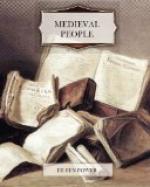The great and noble trade of cloth-making has left many traces upon the life of England, architectural, literary, and social. It has filled our countryside with magnificent Perpendicular churches and gracious oak-beamed houses. It has filled our popular literature with old wives’ tales of the worthies of England, in which the clothiers Thomas of Reading and Jack of Newbury rub elbows with Friar Bacon and Robin Hood. It has filled our shires with gentlemen; for, as Defoe observed, in the early eighteenth century ’many of the great families who now pass for gentry in the western counties have been originally raised from and built up by this truly noble manufacture’. It has filled our census lists with surnames—Weaver, Webber, Webb, Sherman, Fuller, Walker, Dyer—and given to every unmarried woman the designation of a spinster. And from the time when the cloth trade ousted that of wool as the chief export trade of England down to the time when it was in its turn ousted by iron and cotton, it was the foundation of England’s commercial greatness. ‘Among all Crafts,’ says old Deloney, ’this was the only chief, for that it was the greatest merchandize, by the which our Country became famous thorowout all Nations.’[1]
Already by the end of the fourteenth century the English clothiers were beginning to rival those of the Netherlands in the making of fine cloth, as witness Chaucer’s Wife of Bath:
Of clooth-making she hadde swiche an haunt
She passed hem of Ypres and of Gaunt,
and by the end of the sixteenth century all real rivalry was at an end, for the English manufacture was so clearly victorious. With the development of the manufacture a change too took place in its organization. It had never been an easy industry to organize on a gild basis, because the making of a piece of cloth entailed so many distinct processes. The preliminary processes of spinning and carding were always by-industries, performed by women and children in their cottages; but the weavers, who bought the spun yarn, had their gild; and so had the fullers, who fulled it; and the shearmen, who finished it; and the dyers who dyed it. All could not sell the finished piece of cloth, and in the group of inter-dependent crafts, each with its gild, we sometimes find the weavers employing the fullers and sometimes the fullers the weavers. Moreover, since weaving is a much quicker process than spinning, the weaver often wasted much time and found it hard to collect enough yarn to keep his loom busy; and, as the market for cloth grew wider and was no longer confined to the town of the weaver, the need was felt for some middleman to specialize in the selling of the finished cloth. So by degrees there grew up a class of men who bought wool in large quantities and sold it to the weavers, and then by a natural transition began, not to sell the wool outright, but to deliver it to the weavers to weave, to the fullers to full, and to the shearmen to finish at a wage, receiving




